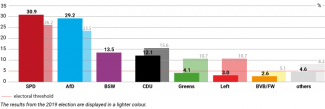Success for the SPD in Brandenburg
On 22 September, the SPD, which has governed Brandenburg since 1990, once again secured victory in the state’s legislative assembly (the Landtag) elections. The party of Prime Minister Dietmar Woidke garnered 30.9% of the vote, an increase of 4.7% compared to 2019, securing 32 seats in the 88-member parliament. The AfD came second with 29.2% (an increase of 5.7%, 30 seats). Sahra Wagenknecht’s Alliance for Reason and Justice (BSW) also entered the Landtag with 13.5% (14 seats), as did the CDU, which had been part of the ruling coalition in Brandenburg and received 12.1% (a decrease of 3.5%, 12 seats). Several parties that had previously been represented in the Landtag, including the Greens (4.1%; another part of the ruling coalition in the previous legislature), Die Linke (3%) and the Free Voters (FW; 2.6%), failed to cross the 5% electoral threshold. The FDP once again fell below the threshold with just 0.8% of the vote.
The election results represent a success for Brandenburg’s Prime Minister Woidke, who turned the campaign into a referendum on his own popularity, distancing himself from the SPD-led federal government. Meanwhile, the AfD once again demonstrated that it is a mass party in the eastern states; it will be the strongest opposition party in Brandenburg, with the ability to block decisions requiring a two-thirds majority. The AfD benefited from the highest voter turnout in the state’s post-1990 history (72.9%, an increase of 11.6 percentage points).
The BSW’s support will be necessary to form a majority coalition, as was the case following the elections in Thuringia and Saxony. The new government must be formed within three months of the Landtag’s first session, with key campaign issues focussing on limiting migration to Germany, the war in Ukraine, and various social issues.
Commentary
- The SPD won as a result of the popularity and commitment of the state’s prime minister and his effective election campaign, in which he promised to resign if his party lost to the AfD. As many as 65% of Brandenburg residents (including 28% of AfD voters) believe that Woidke has performed well as the head of government. The incumbent prime minister turned the election in his favour by winning over a significant portion of those who had previously voted for the Greens (47,000) or Die Linke (25,000) and by securing the support of the oldest voters: 49% of those over the age of 70 voted for the SPD. The party’s decision to exclude Chancellor Olaf Scholz from the campaign proved to be the right move, as only 20% of voters in Brandenburg, including 41% of SPD supporters, are satisfied with the federal government’s performance.
- The SPD’s victory in Brandenburg will defer discussions within the party on whether to replace the unpopular Scholz as the Social Democrats’ candidate in the next Bundestag election, scheduled for 28 September 2025. However, these debates will not subside, as the Brandenburg election has demonstrated that a party’s electoral success heavily depends on its leader. Meanwhile, further defeats for the Greens and the FDP in the recent state elections will intensify existing tensions within the SPD-Green-FDP coalition. If its leaders fail to agree on the budget by November, the possibility of early elections will become more realistic.
- The AfD’s strong performance has demonstrated that in the eastern Länder, it functions as a mass party with broad support across all voter groups. Once again, it was the most popular party among the youngest voters, winning 31% of the vote among those aged 16-24. As in Thuringia and Saxony, most voters chose the AfD primarily because of its programme (particularly appreciating its competence on internal security issues) rather than out of disillusionment with other parties. It received its highest support in heavily depopulated rural municipalities, especially those near the Polish border and in south-eastern Brandenburg, where it garnered over 40% of the vote. A total of 79,000 people who had not participated in the previous elections cast their votes for the AfD this time.
- Brandenburg is the third state where the BSW’s support will be required to form a majority government. An SPD-BSW coalition and an SPD-CDU minority government are viable options, as all parties have ruled out forming a government with the AfD. One factor favouring a coalition between Wagenknecht’s party and the SPD is that the BSW’s regional leader, Robert Crumbach, is a well-known figure among the local Social Democrats, having been a member of the SPD for the past three decades. The BSW attracted the most votes from disillusioned Die Linke voters (44,000) and those who had previously abstained from voting (41,000). The party is particularly appealing to senior citizens (those aged over 60). For its electorate, the most critical issues in the recent campaign were the war in Ukraine (the BSW wants to end support for Ukraine), social welfare, and the inequalities between eastern and western Germany.
- The defeat of the CDU, which suffered its worst-ever election result in the eastern states, can be attributed to the low profile and campaign mistakes of its main candidate in Brandenburg, Jan Redmann. Some of the party’s former voters (13,000) shifted their support to Woidke, whom the majority of CDU supporters (69%) and the popular CDU prime minister of neighbouring Saxony, Michael Kretschmer, consider a good state leader. Despite the CDU’s poor performance in Brandenburg, Friedrich Merz will remain the CDU’s and CSU’s joint candidate for chancellor in 2025 and will retain a strong position within his party.
APPENDIX
Chart 1. Preliminary results of the Brandenburg Landtag election

Source: the author’s own compilation based on data from the state election commission.
Chart 2. Distribution of seats in the Landtag of Brandenburg

Source: the author’s own compilation based on data from the state election commission.





